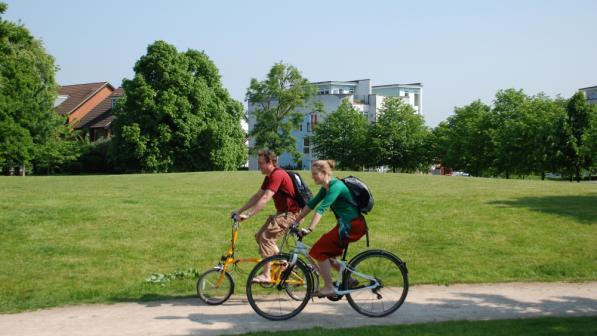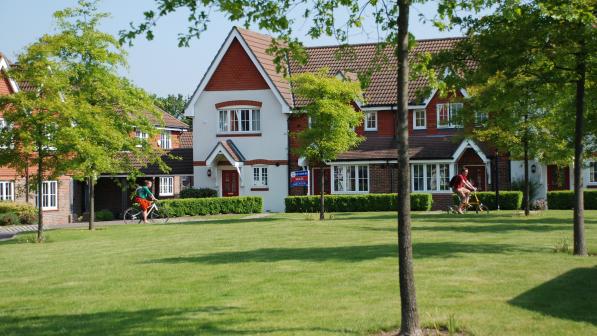Cycle-friendly design and planning: Overview
By Cherry

The design and planning of the road network needs to be cycle-friendly
Headline message
- Cycling UK’s vision is to see a massive step-change in cycle use, so that people of all ages, backgrounds and abilities feel able to cycle safely and confidently for all types of journey.
- Our neighbourhoods, town centres and road networks should be fundamentally redesigned to be ‘people-friendly’, with cycling not only contributing to a reduction in car dependence, but also benefiting from it. Through-traffic should be channelled onto a limited network of main roads – which should have dedicated cycle provision on or alongside them – while traffic volumes and speeds are kept low on other streets or lanes. Dedicated cycle routes and cycle-friendly access restrictions (e.g. limiting motorised access to town-centres or rat-runs) can encourage people to choose cycling over motorised travel for day-to-day journeys.
- The cycle network should include the whole road network, supplemented by high-quality cycle routes away from the road network, e.g. through parks and open spaces, or along canals, waterfronts and disused rail corridors. Dedicated cycle provision should be safe and feel safe, showing that society positively values those who choose to cycle, and avoiding any impression that they are a ‘nuisance’ to be ‘kept out of the way of the traffic.’
- In general, Cycling UK advocates:
- 20 mph limits for most built-up streets (including villages), and the widespread adoption of 40 mph or lower limits for rural lanes;
- Some form of dedicated space on busier urban roads, particularly where higher speed limits are retained; and
- Parallel off-road facilities for dual carriageways and inter-urban roads.
- However, decisions on appropriate solutions will also need to reflect local factors, such as junctions and junction layouts, and demand for parking or loading.
- In most places, the main priority for significant capital spending in the years ahead will be to redesign larger junctions to be cycle-friendly, or to open up links for cyclists across (or avoiding) major barriers to safe and convenient cycle travel. Opportunities should also be sought to maximise the funding for cycling improvements through the planning system and road maintenance budgets.
Important!
Please note: in July 2020, the Department for Transport published new guidance on cycle infrastructure design (LTN1/20). We will be revising all our advice, policy and materials on infrastructure in the light of it as soon as possible. This exercise will include reviewing this page.
Please also note existing cycle infrastructure design guidance for London, Wales and Scotland (revision due). Plus, technical guidance for Local Cycling and Walking Infrastructure Plans (LCWIPs, England).
Cycling UK view
General principles:
- An overall aim of transport planning should be to increase cycling as part of a strategy to halt and reverse the growth of motor traffic. This could be achieved through pricing mechanisms (e.g. fuel duty, road user charging, and tax incentives for cycling), the availability or cost of parking, or by regulations and physical road closures to limit motor vehicle access whilst maintaining access for cyclists.
- The road network and cycle facilities should be designed and maintained to a high standard, free of potholes, debris and obstructions.

Urban streets and rural lanes:
- 20 mph limits should be the norm for most streets in built-up areas, with exceptions to be identified by local authorities in consultation with local communities.
- Speed limits of 40 mph or lower should be the norm for rural single carriageways, with 20 mph the norm in villages.
- On both residential streets and rural lanes, low traffic speeds should preferably be achieved through quality design, to make the street or lane feel like it is primarily for people not motor vehicles. Cruder forms of traffic calming, such as road humps and narrowings, are a less good option, as they can be unpleasant and unsafe for cyclists, and are generally unpopular.
- On busier urban roads, some form of dedicated space for cyclists should be provided. Alternatively, this may include use of decent width bus lanes or on carriageway cycle lanes, preferably with coloured surfacing. It may also include cycle lanes created from carriageway space involving physical segregation both from motor vehicles and pedestrians, where the relevant highway authority has the will to do this to a high standard. Where there is insufficient space for such provision, the aim must be to reduce traffic volumes and/or speeds, so that cyclists can share the road safely with the other traffic using it.
Dual carriageways, inter-urban main roads and major junctions:
- On dual carriageways and inter-urban main roads, the form of cycle provision normally preferred should be a physically segregated cycle track parallel to the road, with provision made for cyclists to pass under, over, around or through major junctions.
- High speed or multi-lane junctions should either have signalised crossing points, ‘early advance’ cyclists’ traffic lights, and/or safe and convenient bypass routes, bridges or underpasses, so that cyclists can get round or through the junction safely and conveniently in all directions.
- Bridges and tunnels designed to high standards should be provided at appropriate locations to enable cyclists and other non-motorised users to cross major roads where potential links on minor roads or off-road rights of way are currently severed.
Off-road cycle facilities:
- Traffic-free routes should be provided away from roads, e.g. using parks and open spaces, canal and riversides. These should form direct and convenient connections to the wider road network and to key destinations, and should have good riding surfaces.
- Traffic-free routes away from roads should add to, not substitute for, the creation of safe, convenient and pleasant cycling conditions on or adjacent to the road network, so that cyclists have easy access to the full range of destinations that other road users can get to.

Other cycling infrastructure:
- Cycle signing should be provided to help people find suitable routes.
- Sensibly-designed cycle parking should be provided at key destinations to meet the needs of both short-stay visitors and longer-stay users e.g. at schools, workplaces and rail stations which will generally require more secure, sheltered provision. Levels of cycle parking provision should reflect anticipated increases in demand.
Maintenance and funding sources:
- Roads and off-road routes used by cyclists should be surfaced and maintained to a high standard. The needs of cyclists should be reflected in highway authorities’ procedures for reporting, inspecting and repairing defects, and in the management of street works, winter maintenance, debris/vegetation clearance and lighting policies.
- The costings of off-road cycle facilities should include provision for their maintenance.
- Opportunities should be sought to maximise the funding available for improved cycling provision from new developments and highway maintenance budgets.
Ensuring high and consistent quality:
- Planners and engineers should be given professional training in the principles of cycle-friendly planning and design.
- The highway network and alterations to it should be subjected to a cycle audit and review process.
See our Space for Cycling guide for decision makers for more on the kind of infrastructure Cycling UK is calling on councils to introduce throughout the country.
2012-09-29 00:00:00 Europe/London

